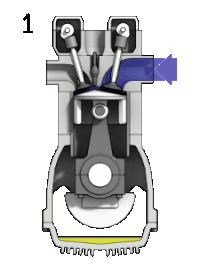
A petrol engine (gasoline engine in American and Canadian English) is an internal combustion engine designed to run on petrol (gasoline). Petrol engines can often be adapted to also run on fuels such as liquefied petroleum gas and ethanol blends (such as E10 and E85 ). They may be designed to run on petrol with a higher octane rating, as sold at petrol stations.
Contents
- History
- Design
- Thermodynamic cycle
- Layout
- Compression ratio
- Cooling
- Ignition
- Primer
- Power output and efficiency
- Applications
- See also
- References
Most petrol engines use spark ignition, unlike diesel engines which run on diesel fuel and typically use compression ignition. Another key difference to diesel engines is that petrol engines typically have a lower compression ratio. [1] [2] [3]
